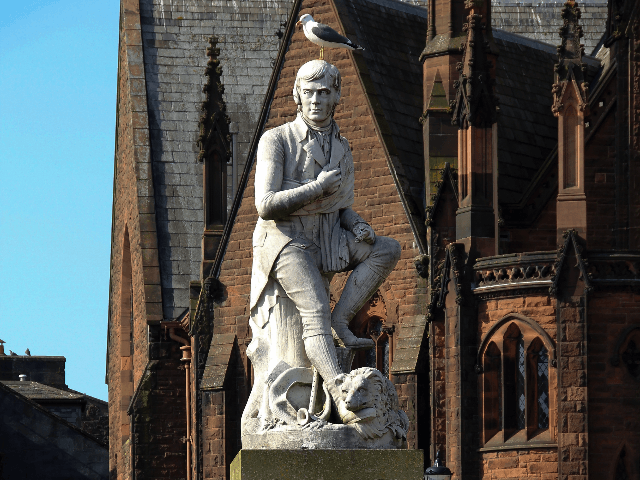A review of statues, place names, and other memorials inspired by Black Lives Matter in Edinburgh, Scotland, has figures including Queen Victoria, Admiral Nelson, and even Scotland’s national poet, Robert ‘Rabbie’ Burns, in its sights, according to reports.
The Slavery and Colonialism Legacy Review Group, commissioned by the Scottish capital’s municipal government — a coalition between the left-separatist Scottish National Party (SNP) and the left-wing Labour Party — has even named Bute House, the official residence of SNP leader and Scottish First Minister Nicola Sturgeon, as a site of “historic racial injustice”, according to the Telegraph, because its builders inherited some wealth from Caribbean plantations.
Burns, famous around the world as the Bard of Ayrshire, with a statue adorning Central Park in Manhattan, New York, was targeted by the review despite supporting the abolition of slavery because he once “accepted a job working on a Jamaican plantation in a role he described as a ‘Negro driver’” — although he never actually followed through on the job.
David Hume, an icon of the Scottish Enlightenment and something of a progressive thinker for his day, has also been singled out for occasionally expressing views that would be considered insensitive by the standards of 2021 — over three centuries on from the year of his birth. The Univesity of Edinburgh has already renamed Hume Tower, which took its moniker from its once-celebrated former student.
Statue of Queen Elizabeth II Beheaded in Victoria, Canada https://t.co/vwXnp74h7O
— Breitbart London (@BreitbartLondon) February 26, 2021
Admiral Horatio Nelson, hero of the Battle of Trafalgar, was accused — dubiously — of opposing the abolition of the slave trade, while William Ewart Gladstone, who served four times as Prime Minister and was heralded as a leader approaching the stature of Sir Winston Churchill in a more historically literate era, was targeted because his father owned plantations in the Caribbean and British Guiana which at one time used slave labour.
The dossier reportedly names Queen Victoria, likely the most iconic of Britain’s monarchs, simply because she was a “colonial ruler”.
The Slavery and Colonialism Legacy Review Group has been led by Sir Geoff Palmer, who is Scotland’s first black professor — but not a historian, having made his name as a grain scientist.
Sir Geoff has previously campaigned against Henry Dundas — who also appears in the review — and successfully persuaded the authorities to “recontextualise” the stone column and statue memorialising him in Edinburgh with an information board which asserts that he was personally responsible for delaying the abolition of the slave trade and the deaths of thousands of slaves.
Historians and descendants of Dundas have argued that the board is historically inaccurate, noting that Dundas never owned slaves, supported the gradual abolition of slavery, and had no means of effecting its immediate abolition.
Dundas was one of the most powerful politicians of his day, with immense influence in the British government, and in his younger days helped to establish that slavery had no legal standing in Scotland proper as lawyer for the runaway slave Joseph Knight.
Robert Poll of the Save Our Statues campaign described the Edinburgh Council review as a “Kangaroo Court of Scottish History” and dismissed Sir Geoff as “Another activist [re]writing history.”
Edinburgh Castle Changing War Heroes’ Memorial After One Person Complained of ‘Imperialism’ https://t.co/GJHx5nBokx
— Breitbart London (@BreitbartLondon) November 20, 2020

COMMENTS
Please let us know if you're having issues with commenting.